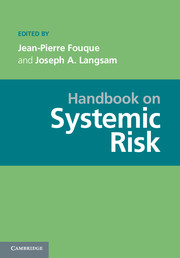Book contents
- Frontmatter
- Contents
- Contributors
- Introduction
- PART I DATA: THE PREREQUISITE FOR MANAGING SYSTEMIC RISK
- PART II STATISTICS AND SYSTEMIC RISK
- PART III MEASURING AND REGULATING SYSTEMIC RISK
- PART IV NETWORKS
- PART V SYSTEMIC RISK ANDMATHEMATICAL FINANCE
- PART VI COUNTERPARTY RISK AND SYSTEMIC RISK
- PART VII ALGORITHMIC TRADING
- PART VIII BEHAVIORAL FINANCE: THE PSYCHOLOGICAL DIMENSION OF SYSTEMIC RISK
- 23 Fear, Greed, and Financial Crises: A Cognitive Neurosciences Perspective
- 24 Bubbles, Crises, and Heterogeneous Beliefs
- 25 Systemic Risk and Sentiment
- PART IX REGULATION
- PART X COMPUTATIONAL ISSUES AND REQUIREMENTS
- PART XI ACCOUNTING ISSUES
- References
23 - Fear, Greed, and Financial Crises: A Cognitive Neurosciences Perspective
from PART VIII - BEHAVIORAL FINANCE: THE PSYCHOLOGICAL DIMENSION OF SYSTEMIC RISK
Published online by Cambridge University Press: 05 June 2013
- Frontmatter
- Contents
- Contributors
- Introduction
- PART I DATA: THE PREREQUISITE FOR MANAGING SYSTEMIC RISK
- PART II STATISTICS AND SYSTEMIC RISK
- PART III MEASURING AND REGULATING SYSTEMIC RISK
- PART IV NETWORKS
- PART V SYSTEMIC RISK ANDMATHEMATICAL FINANCE
- PART VI COUNTERPARTY RISK AND SYSTEMIC RISK
- PART VII ALGORITHMIC TRADING
- PART VIII BEHAVIORAL FINANCE: THE PSYCHOLOGICAL DIMENSION OF SYSTEMIC RISK
- 23 Fear, Greed, and Financial Crises: A Cognitive Neurosciences Perspective
- 24 Bubbles, Crises, and Heterogeneous Beliefs
- 25 Systemic Risk and Sentiment
- PART IX REGULATION
- PART X COMPUTATIONAL ISSUES AND REQUIREMENTS
- PART XI ACCOUNTING ISSUES
- References
Summary
Abstract Historical accounts of financial crises suggest that fear and greed are the common denominators of these disruptive events: periods of unchecked greed eventually lead to excessive leverage and unsustainable asset-price levels, and the inevitable collapse results in unbridled fear, which must subside before any recovery is possible. The cognitive neurosciences may provide some new insights into this boom/bust pattern through a deeper understanding of the dynamics of emotion and human behavior. In this chapter, I describe some recent research from the neurosciences literature on fear and reward learning, mirror neurons, theory of mind, and the link between emotion and rational behavior. By exploring the neuroscientific basis of cognition and behavior, we may be able to identify more fundamental drivers of financial crises, and improve our models and methods for dealing with them.
Introduction
In March 1933, unemployment in the United States was at an all-time high. Over 4,000 banks had failed during the previous two months. Bread lines stretched around entire blocks in the largest cities. The country was in the grip of the Great Depression. This was the context in which Franklin Delano Roosevelt delivered his first inaugural address to the American people as the 32nd president of the United States. He began his address not by discussing economic conditions, nor by laying out his proposal for the “New Deal”, but with a powerful observation that still resonates today: “So, first of all, let me assert my firm belief that the only thing we have to fear is fear itself – nameless, unreasoning, unjustified terror which paralyzes needed efforts to convert retreat into advance”.
- Type
- Chapter
- Information
- Handbook on Systemic Risk , pp. 622 - 662Publisher: Cambridge University PressPrint publication year: 2013
References
- 11
- Cited by



